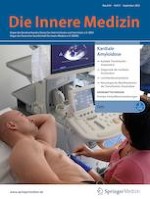Erschienen in:

04.08.2023 | Amyloidose des Herzens | Schwerpunkt: Kardiale Amyloidose
Kardiale ATTR-Amyloidose
verfasst von:
PD Dr. med. Frauke Czepluch
Erschienen in:
Die Innere Medizin
|
Ausgabe 9/2023
Einloggen, um Zugang zu erhalten
Zusammenfassung
Kardiale Transthyretin-Amyloidosen (ATTR-Amyloidosen) sind eine unterdiagnostizierte Ursache von Herzinsuffizienz und Arrhythmien. Insbesondere bei älteren Patienten mit einer linksventrikulären Hypertrophie (LVH), die gleichzeitig an einer Herzinsuffizienz mit erhaltener Ejektionsfraktion (HFpEF) oder Aortenklappenstenose leiden, sollte an diese Differenzialdiagnose gedacht werden. ATTR-Amyloidosen sind entweder genetisch bedingt oder entstehen durch Alterungsprozesse. Durch die extrazelluläre Akkumulation von Amyloidfibrillen im Herzen kommt es zu einer restriktiven Kardiomyopathie, die zu typischen Herzinsuffizienzsymptomen sowie Erregungsleitungs- und Erregungsrückbildungsstörungen führt. Auch extrakardiale Probleme wie ein Karpaltunnelsyndrom können auf eine kardiale ATTR-Amyloidose hindeuten. Die Erkrankung kann durch eine Myokardbiopsie oder alternativ durch eine positive Skelettszintigraphie bei gleichzeitigem Ausschluss monoklonaler Proteine im Blut und Urin diagnostiziert werden. Neben einer symptomatischen Therapie steht mittlerweile mit dem Transthyretin(TTR)-Stabilisator Tafamidis ein Medikament zur Verfügung, das den Krankheitsverlauf signifikant verlangsamen kann. In den nächsten Jahren ist mit der Zulassung weiterer Medikamente zur Behandlung der kardialen ATTR-Amyloidose zu rechnen.